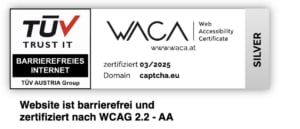
Table of contents
In the digital world, we regularly encounter small security checks asking us to select images, decipher distorted letters, or simply click a checkbox. These hurdles serve an important purpose: they protect websites from automated attacks. But how exactly do these protection mechanisms work, and what should we consider regarding data privacy?
What is CAPTCHA and what is it used for?
CAPTCHA stands for “Completely Automated Public Turing test to tell Computers and Humans Apart” – a rather complex name for a simple concept: it’s a test designed to distinguish humans from computer programs. We encounter these tests throughout the internet: when filling out contact forms, creating accounts, or shopping online.
The main purpose of CAPTCHAs is to protect against automated programs, known as bots, that might try to:
- Send mass spam messages
- Create accounts to abuse systems
- Crack passwords through repeated attempts
- Buy up tickets or products to resell them at higher prices
- Flood comment sections with advertisements or misinformation
By using CAPTCHA systems, websites can ensure that only real humans perform certain actions – an essential building block for internet security.
What types of CAPTCHA’s exist?
Over time, various CAPTCHA methods have developed, each with its own strengths and weaknesses:
Text-based CAPTCHAs
With this classic method, users must recognize and enter distorted letters or numbers. Although long considered standard, modern AI systems can now often bypass these tests.
Image-based CAPTCHAs
Here, users are asked to identify specific objects in images – such as clicking on all traffic lights, crosswalks, or vehicles. This method is usually intuitive for humans but can create barriers for people with visual impairments.
Audio CAPTCHAs
Audio CAPTCHAs were developed as an alternative for visually impaired people, where letters or numbers are read aloud. Users must enter what they hear. However, these recordings are often deliberately distorted, which can make comprehension difficult.
Logic and Math Problems
Simple puzzles or mathematical tasks are also part of the CAPTCHA repertoire. They are easy for humans to solve but present a challenge for automated programs.
Behavior-based CAPTCHAs
Modern systems analyze user behavior in the background. How does the mouse cursor move? How quickly are forms filled out? Based on these patterns, the software can assess whether it’s dealing with a human or an automated program.
Invisible CAPTCHAs
The newest generation works completely in the background and no longer requires direct interaction. Instead, various factors are analyzed to determine if the user is human – a major advantage for user-friendliness.
Advantages and disadvantages of CAPTCHA systems
CAPTCHAs offer important benefits:
- They protect websites from automated attacks and spam
- They prevent the misuse of online services
- They reduce server load from bot traffic
- They help maintain the integrity of votes and surveys
However, there are also significant disadvantages:
- They can disrupt the user experience and lead to frustration
- They often create barriers for people with disabilities
- They can be time-consuming and lower website conversion rates
- Advanced bots can now bypass many traditional CAPTCHAs
- Some solutions raise considerable privacy concerns
Privacy Aspects: The Difference Between US and European Solutions
A particularly important aspect when using CAPTCHA technologies is data privacy. This is where American and European approaches differ significantly.
US CAPTCHA Solutions and Privacy Concerns
The most well-known CAPTCHA provider worldwide is Google with its reCAPTCHA service. While this solution is very effective, it collects extensive data about user behavior in the background. This happens not just on the website where the CAPTCHA appears but can extend to overall browsing behavior if the user is logged into Google services.
This data collection potentially includes:
- IP addresses
- Cookie information
- Click and movement patterns
- Browser information
- Device data
- Browsing behavior across different websites
For European users and companies, this presents a problem as these practices may not be fully compatible with the General Data Protection Regulation (GDPR). The GDPR requires clear consent for data processing and limits the amount of data collected to what is necessary.
European Data Protection Standards
In Europe, data protection is considered a fundamental right. The GDPR places high demands on companies:
- Data minimization: Only data necessary for the specific purpose may be collected
- Transparency: Users must be clearly informed about what data is collected and how it is used
- Consent: For processing personal data, explicit consent is required in many cases
- Data security: Collected information must be adequately protected
- Rights of data subjects: Users have the right to access, delete, and correct their data
European Alternatives: Captcha.eu as a Privacy-Friendly Solution
In light of these challenges, European alternatives have emerged that offer both security and compliance with data protection standards. A leading solution in this area is captcha.eu, a CAPTCHA service developed and hosted in Europe.
Captcha.eu differs from US alternatives in important ways:
- European Data Storage: All data is processed and stored exclusively on European servers, which significantly simplifies GDPR compliance.
- Data Minimization: Captcha.eu operates on the principle of data minimization and only collects information that is truly necessary to distinguish between humans and machines.
- No Profile-Building Data Collection: Unlike some US solutions, captcha.eu does not create comprehensive user profiles and does not track behavior across different websites.
- Accessibility: Captcha.eu places special emphasis on accessibility. The service is certified as barrier-free by TÜV Austria and carries the WACA Silver certification, making it usable for people with disabilities.
- Easy Integration: The solution can be easily integrated into common content management systems such as WordPress, TYPO3, NeosCMS, Joomla, and Magento, but also into individual web projects via standardized APIs.
This combination of security, data protection, and accessibility makes captcha.eu a compelling alternative for European companies that want to both protect their websites and respect the privacy of their users.
Conclusion: Making the Right CAPTCHA Choice
When selecting a CAPTCHA system, website operators should consider several factors:
- Security Level: How well does the solution protect against current bot attacks?
- User-Friendliness: Is the user experience affected as little as possible?
- Accessibility: Can all users, regardless of potential limitations, use the website?
- Data Protection: Is personal data processed in accordance with GDPR?
- Transparency: Is it clear what data is collected and how it is used?
For European companies, a GDPR-compliant solution like captcha.eu offers the advantage of legal certainty while strengthening user trust. In an era of increasing data protection awareness, this can be an important competitive advantage.
The decision for a CAPTCHA system should ultimately be based not only on technical aspects but also reflect your own company values – particularly your attitude toward protecting privacy and ensuring digital offerings are accessible to all user groups.




